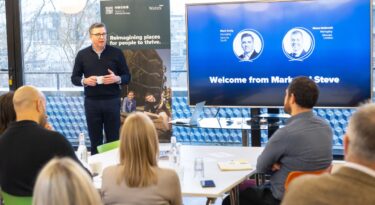The UK is home to more small businesses than any other country in Europe and this unique entrepreneurial spirit – celebrated on TV shows from Dragons’ Den to The Apprentice is key to accelerating our national drive to net zero.
We’ve recently celebrating four of those businesses, the winners of our green innovation competition with Lloyds Banking Group, who will now have the opportunity to be piloted across Lloyds’ branch and office estate, as well as being added to our Wates Innovation Network (WIN) Portal as Innovation Partners. Each has the ability to affect positive change within the built environment, be that an AI thermostat that improves air conditioning efficiency to friendly bacteria that reduce wastewater.
Too often, however, new sustainable technologies fly under the radar because suppliers are unable to get in front of the right decision makers. A staggering 95% of products never get considered because key decision makers are not aware of them, and suppliers don’t have access to the right people. Even when they are considered, there can be a tendency to fall back on outdated products due to red tape surrounding decision making processes. Or, conversely, there is a risk that new products are rolled out without being rigorously reviewed.
Cutting the red tape without compromising on quality
Through our WIN Portal we are aiming to unearth and champion new sustainable technologies for the built environment, giving suppliers the opportunity to connect their products with customers that will test their viability in a live environment and whether they can ultimately be rolled out at scale.
With over 100 applications to our competition with Lloyds, however, selecting our winners and Innovation Partners was a rigorous process – involving deep dive desk reviews, assessment by our Technical Advisory Panel and virtual pitches, as well as a final in person pitch, which took place at the Shard, London.
Before we put a business forward, we want to be confident of their potential and, at the beginning of our collaboration with Lloyds, we worked together to set out our essential criteria for an Innovation Partner.
So, what does it take? First, we considered the attractiveness of each product, considering the following factors:
- Credibility: for Lloyds, credibility was key and held a 30% weighting in our scoring. We were looking for suppliers that could prove how they would deliver against Lloyds’ ambitious environmental targets to reach net zero carbon operation, reduce energy consumption and water usage. For example, case studies that demonstrated how the products would work in action, tangible evidence for savings, and relevant accreditations.
- Compliance: suppliers need to show that they are compliant with building regulations, as well as other voluntary and mandatory legislation. We were also looking for products that were compatible with those already in use across the Lloyds estate and could therefore be easily adopted.
- Return on investment (ROI): for any product to be a success, it needs to demonstrate that the initial investment required will ultimately result in net gains. Where suppliers could set out impressive projections for ROI, it supported their business case by showcasing the impact they might have on Lloyds’ bottom line.
- Impact: the judges were also looking for products which demonstrated their USP and crucially had that ‘wow-factor’. We wanted suppliers to consider the full impact of their product, not just on the environment, but from wellbeing through to the productivity of the building’s users.
As well as a product’s attractiveness, suppliers also had to demonstrate its competitiveness. Namely, the investment and maintenance costs required, the environmental and operational savings it would bring, and its scalability.
Investing in the green tech businesses of the future
All our winners proved that they have incredible potential to be rolled out in buildings up and down the country. The reality is, however, that many businesses are nervous about trialing new products and avoid acting as early adopters of innovation. This inhibits small businesses who need those early examples of success if they are to grow and develop. We all want to mitigate risk. But, the biggest risk of our time is climate change, and if we are to achieve net zero, it is critical that we nurture and support these technologies.
It is only through collaboration that we have been able to do this, with Wates bridging the gap between suppliers and Lloyds’ key decision makers. Ultimately, we hope to see more of this, be that in the construction or banking sector we need to explore ways to share our successes, so that all businesses can find quicker routes to reduce waste and improve efficiencies.





